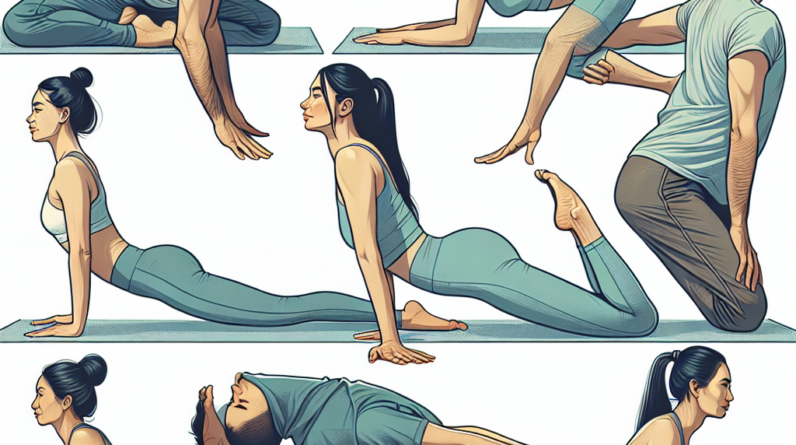
Understanding the Basics of Flexibility
What is Flexibility?
Flexibility is that magical ability to stretch and bend your body in ways that seem effortless. For me, it started as just wanting to touch my toes, but it quickly evolved. Flexibility is the range of motion in joints and muscles, and having good flexibility is crucial for everything from simple movements in daily life to performing in sports. Just think about the extension on that last jump shot or even bending over to tie your shoes!
Get a Huge Discount and Bonus! Try for 90 Days Risk Free
As we age, flexibility tends to decrease, so it’s especially important to integrate practices that promote flexibility. Who wouldn’t want to still be doing the splits at 70? Plus, improving this aspect can help prevent injuries, as a flexible body often withstands strains better than a rigid one.
In yoga, flexibility isn’t just a goal; it’s a process. And believe me, every little bit counts. When I started my yoga journey, I couldn’t have imagined myself enjoying these deep stretches, but letting my body gradually open up has been such a rewarding experience.
Why Yoga for Flexibility?
So, what makes yoga a go-to for enhancing flexibility? First off, it combines structured movement with deep breathing, which helps relax the body. When I’m in a yoga class, focusing on my breath really helps me sink deeper into the poses.
Yoga also promotes mindfulness, making me more aware of my body and its limits. This mindfulness often translates to my everyday activities, encouraging me to move in a way that maintains rather than strains my body. I’ve found that the more I practice, the more natural these movements become.
Finally, yoga offers a variety of poses targeting different muscle groups. This means there’s something for everyone, whether you’re a beginner or a seasoned yogi. My go-to poses have become trusted friends, helping me open up tight areas I didn’t even know existed!
Getting Started with Your Practice
If you’re eager to dive in, the key is starting slowly. Grab a yoga mat, some comfy clothes, and maybe a few props like blocks or straps. I still remember the first time I stepped onto my mat; it was intimidating but exhilarating!
Make sure to carve out some time for practice; consistency is vital. I usually aim for a few sessions a week, and finding a schedule that fits your lifestyle will keep you motivated. Even 20 minutes here and there can make all the difference.
Lastly, don’t hesitate to reach out to a local class or community. Practicing with others can provide both accountability and camaraderie, which has propelled my practice further than I could’ve achieved alone.
Get a Huge Discount and Bonus! Try for 90 Days Risk Free
Incorporating Specific Poses
Sun Salutations
Ah, the Sun Salutation! It’s like the bread and butter of yoga. I love starting my practice with a few rounds of this sequence to warm up my body. It gently stretches almost every muscle group and gets the energy flowing.
Each movement is linked with breath, making it a dynamic warm-up. I find it helps me tune in, letting go of the clutter in my mind. Plus, it creates a rhythm that feels natural and invigorating.
Don’t be afraid to modify as needed! If downward dog feels too intense one day, feel free to drop to your knees. This is about your journey, and every little adjustment can make a world of difference.
Pigeon Pose
Pigeon Pose is one of my all-time favorites for opening up the hips. Honestly, after a long day of sitting, this pose feels like a hug for my tight muscles. It can be quite a challenge at first, but the more I practiced, the more I fell in love with it.
Need a Serious Energy BOOST? Huge Discount Try for 90 Days Risk Free
The key here is to listen to your body. If you feel discomfort, ease out of the pose, use props, or find a position that works for you. I often grab a block to support my hip when I’m in this pose, especially on days when I need it.
I’ve found that spending time in this pose allows me to unlock some emotions as well – crazy, right? Flexibility in the hips can often release tension stored from stress. The more I opened my hips, the lighter and freer I felt overall!
Forward Bends
Forward bends are fantastic for stretching the hamstrings and lower back. I’ve always enjoyed how these poses can feel both grounding and calming. Plus, they encourage me to focus on my breath and let go after a long day.
In my practice, I always remind myself to keep a slight bend in my knees to avoid strain. This adjustment allows me to get the stretch without forcing my body beyond its limits. Flexibility isn’t about how deep you can go; it’s about how you feel within your own range.
Additionally, forward bends paired with calming breaths help reduce stress, which we can all benefit from! It’s become a ritual for me; whenever I feel overwhelmed, a nice forward bend often brings me back to center.
Establishing a Routine
Setting Realistic Goals
When I started improving my flexibility, setting realistic goals was crucial. I learned quickly to appreciate small victories. For me, it was about being able to reach further in a pose rather than trying to achieve a perfect split right off the bat!
Breaking goals into bite-sized chunks helps maintain motivation. I’d give myself monthly challenges like improving my hamstring flexibility or deepening my lunges. Each little improvement felt like a win, and that kept me excited.
Celebrate those small milestones! Maybe it’s finally touching your toes or holding a pose longer than before. Each success fuels the fire to keep practicing and pushing my limits further.
Good Health Solution is Easier Than Most People Think!
Take a Look for Yourself!
Consistency is Key
When it comes to yoga, consistency really is key. I strive to practice at least a few times a week. Some days I can commit a full hour; other days, it’s just 20 minutes. But making the effort to show up, even for a short while, still counts!
Creating a schedule or routine has helped me immensely. I’ve found that practicing during quiet times, such as early mornings or just before bed, works best for me. It allows me to prioritize my practice and integrate it into my daily life.
Also, try mixing up different styles or teachers. Seeing how they teach different poses can spice up your practice and keep you coming back for more. I know I always learn something new or gain fresh insights when I venture outside my routine!
Listening to Your Body
This might be the most important lesson I’ve learned. Every time I step on my mat, I check in with how I feel physically and emotionally. When I listen to my body, I can adapt my practice to fit my current needs. Some days, my body craves a deep stretch, while other days, it just needs relaxation.
Pushing too hard often leads to injury or burnout. Remember, there’s no race in yoga; it’s a lifelong journey! I’ve learned to embrace where I am in my practice, not where I want to be.
Engaging with my breath during practice also enhances this connection. It’s a way to gauge how far I can go in a certain pose and helps determine if I need to ease off. Keeping that balance has made yoga a far more enjoyable experience.
Finding a Community
Joining Classes
Joining a local yoga class can be such a game-changer. When I first started, I was hesitant, but once I took that leap, I can’t tell you how much it enriched my practice. Instructors offer invaluable guidance and make adjustments, helping you get into the right alignment.
The energy of practicing with others is truly uplifting! I found that being surrounded by fellow yoga enthusiasts motivated me to explore deeper in my practice. Everyone is on their own journey, which creates a supportive and encouraging space.
If classes aren’t an option, online communities can also be fantastic! There are tons of classes available via streaming services; this option has allowed me to practice at my own pace and comfort.
Engaging in Online Communities
Don’t underestimate the power of online yoga communities! Many platforms allow you to connect with yogis from around the world. Sharing experiences, challenges, and achievements can be so reassuring; it reminds me that I’m not alone on this journey!
Social media has its pitfalls, but it can also be a treasure trove of inspiration! Following yoga accounts, engaging with challenges, or simply sharing your progress can foster motivation. I love seeing others’ transformations; it keeps the enthusiasm alive!
Plus, many online platforms offer classes that you might not find locally. This has really broadened my horizons in terms of styles and teachings. Who knew there were yoga classes at midnight for aspiring night owls like me!
Sharing Your Journey
Lastly, sharing your own journey can be quite liberating. For me, documenting my practice through journaling or social media serves as a personal record of growth. It’s incredible to reflect back on where I started and see how far I’ve come!
Your experiences could inspire others who might be hesitant about starting their journey. We all crave that sense of community. Whether it’s a blog post, a quick update, or just chatting with a friend, putting your journey out there fosters connections.
It reminds me that we’re all in this together, regardless of where we are in our practice. Every voice matters, and who knows, your story might just encourage someone else to join the circle of yoga!
FAQs about Improving Flexibility with Yoga
1. How long will it take to see improvements in my flexibility?
It varies from person to person, but many start seeing changes within a few weeks of consistent practice. Just remember, flexibility is a journey, so be patient with yourself!
2. Do I need to be flexible to start yoga?
Not at all! Yoga is for everyone, regardless of your current flexibility. The practice itself will help you improve over time.
3. What if I can’t do certain poses?
That’s completely okay! Yoga is about understanding your own body and modifying as needed. Use props or choose alternative poses that are comfortable for you.
4. Should I practice yoga every day?
While daily practice is great if you can manage it, start at a pace that feels comfortable for you. Even a few times a week can lead to significant improvements.
5. What’s the best time to practice yoga?
There isn’t a one-size-fits-all answer. I enjoy practicing in the early morning or late evening, but find a time that fits into your routine and honors your personal needs.








